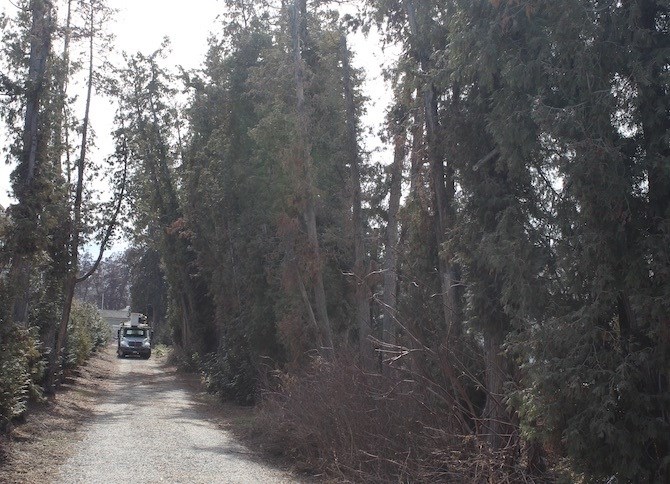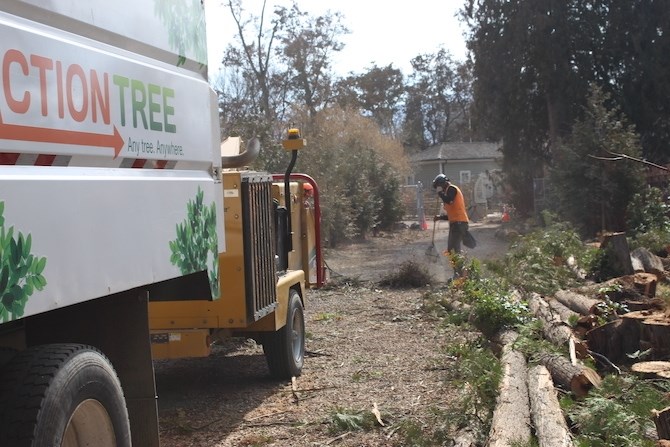
In a press release sent out Monday, March 15, the city said the trees are in the latter part of their lifespan and their condition continues to deteriorate to the point where removal is the only option.
(ROB MUNRO / iNFOnews.ca)
October 23, 2021 - 12:00 PM
- This story was first published March 17, 2021.
If you’ve ever walked through the rows of eastern white cedars near Kelowna’s Guisachan house, you may have heard the faint clip-clop of horses and echoes of laughter that has long since faded away.
It harkens back to the 1890s and is one of this area’s only ghost stories — a happy enough one, for the record.
On the heels of the City of Kelowna's announcement that contractors and parks' staff had begun removing the eastern white cedar trees from the laneway at Guisachan Heritage Park, historian Bob Hayes explained how the foliage had its roots in some colourful history.
“The Guisachan House was built by Lord and Lady Aberdeen in 1891, but they never lived there,” Hayes said. “It was actually bought for Lady Aberdeen’s brother Coutts Marjoribanks and he was a reprobate by any stretch of the imagination.”
Coutts had been sent to North America by the Scottish family in the 1880s.

FILE. Guisachan House.
Image Credit: SUBMITTED/CITY OF KELOWNA
“They wanted to get him out of Scotland and he went to North Dakota to ranch and he loved it but he did everything but ranching,” Hayes said.
From what he’s read, Hayes said Coutts spent his time in the U.S. hunting coyotes, hanging out around the fire with cowboys and drinking a lot.
Unsurprisingly, the North Dakota ranching effort didn’t go well.
So, when Lord and Lady Aberdeen made their way to Kelowna, they visited with Coutts in North Dakota first and decided to intervene.
“They bought the property and that was the original McDougall property and they built the Guisachan house for Coutts,” Hayes said.
“He was supposed to live and ranch there and they built the nearby church, too, thinking Coutts could go on Sundays and stop drinking.”
Ultimately, Lord and Lady Aberdeen were only in Kelowna a few times, but Coutts was “firmly entrenched."
“There was a lot of partying there and the legend was you could hear the carriage pulled by horses, clip-clopping down the lane and stopping at the house,” Hayes said. “The doors of the carriage would open and people would come out laughing and go into the house to party.”
Long before the Okanagan had a wine industry, Hayes surmised there was probably a good amount of good Scottish liquor being poured.
As for Coutts, he eventually moved to Coldstream, where he had more success. He had a family and died years later.
The Guisachan house wasn’t a financial success until the Camerons bought it in 1903.
While the scandalous roots of trees haunted by partiers past may be the highlight of the story, Hayes is taken by the idea of Lady Aberdeen being so devoted to her brother.
“She so wanted him to succeed and he so didn’t want to,” Hayes said.
“It’s a great story and shows the loyalty of Lady Aberdeen to her completely hopeless brother… I gather the support of Coutts did cause strain with her husband.”
Also, the house, the story that goes with it and even the trees that didn’t survive without some help over the years, reflect how Kelowna took shape. Guisachan means Place of the Fir in Gaelic. Fir were the first rows of trees that didn't survive — a nod to Lady Aberdeen's childhood home in the Scottish Highlands.

In a press release sent out Monday, March 15, the city said the trees are in the latter part of their lifespan and their condition continues to deteriorate to the point where removal is the only option.
(ROB MUNRO / iNFOnews.ca)
The new farmhouse was a 'Colonial Bungalow,' whose design was derived from an East Indian house-type. The unusual house was built by David Lloyd-Jones, later the owner of a local sawmill. The house is valued today for its rare architectural style, with wood siding, elaborate moulding and trim under eaves and around windows.
“They tried to recreate mother England and Scotland in the Okanagan,” Hayes said. “They didn’t have fox hunts, but had paper chases, long lanes of the trees and so on.”
In a press release sent out Monday, March 15, the City of Kelowna said the trees are in the latter part of their lifespan and their condition continues to deteriorate to the point where removal is the only option.
“Eastern white cedars are not well suited to the Okanagan climate, requiring significant watering, and these trees had been left unwatered for several years before the City acquired the property in 2016,” according to the release.
Several of the trees have fallen recently, creating a risk of damage to adjacent properties or injury to visitors at Guisachan Heritage Park.
“It’s regrettable, especially given the history of these trees,” Andrew Hunsberger, urban forestry supervisor said in the release. “But we look forward to planting a new species in their place that can thrive and add to our urban canopy.”
New trees will be planted later this year to replace those being removed. A hearty, drought-resistant species, like white fir, will be selected, though the exact species and timeline is still to be determined as the COVID-19 pandemic has made sourcing trees more difficult.
The 300 eastern white cedar that lined the laneway were planted in the late 1800s and draw their historical and emotional significance from their association with Lord and Lady Aberdeen. The Aberdeens had originally planted fir trees they brought from Scotland at the site, but those trees died and were replaced with the white cedar. Lord and Lady Aberdeen were notable early residents of Kelowna and Lord Aberdeen served as Governor General from 1893 to 1898.
For more information about Guisachan Heritage Park, go here.
To contact a reporter for this story, email Kathy Michaels or call 250-718-0428 or email the editor. You can also submit photos, videos or news tips to the newsroom and be entered to win a monthly prize draw.
We welcome your comments and opinions on our stories but play nice. We won't censor or delete comments unless they contain off-topic statements or links, unnecessary vulgarity, false facts, spam or obviously fake profiles. If you have any concerns about what you see in comments, email the editor in the link above.
News from © iNFOnews, 2021